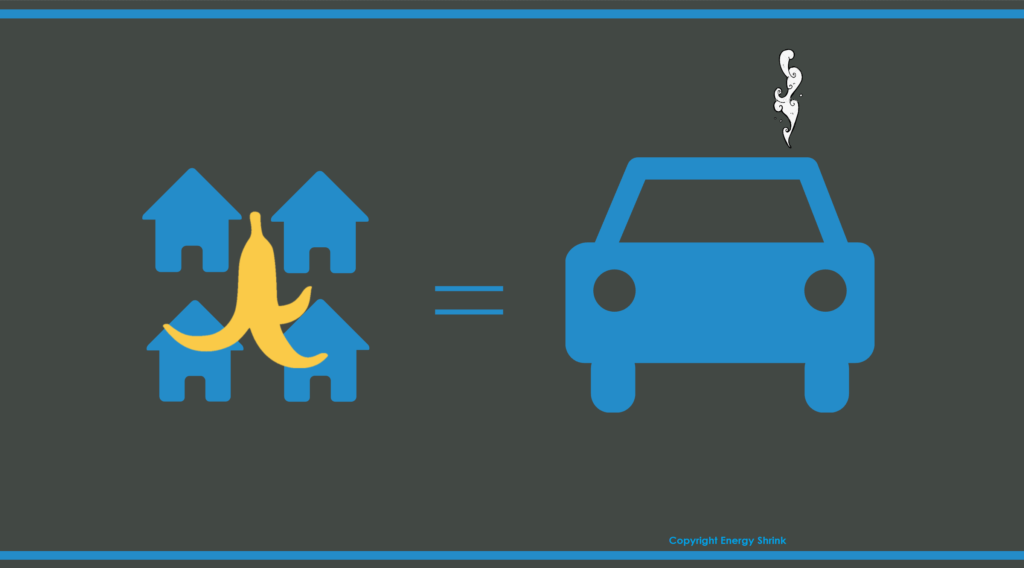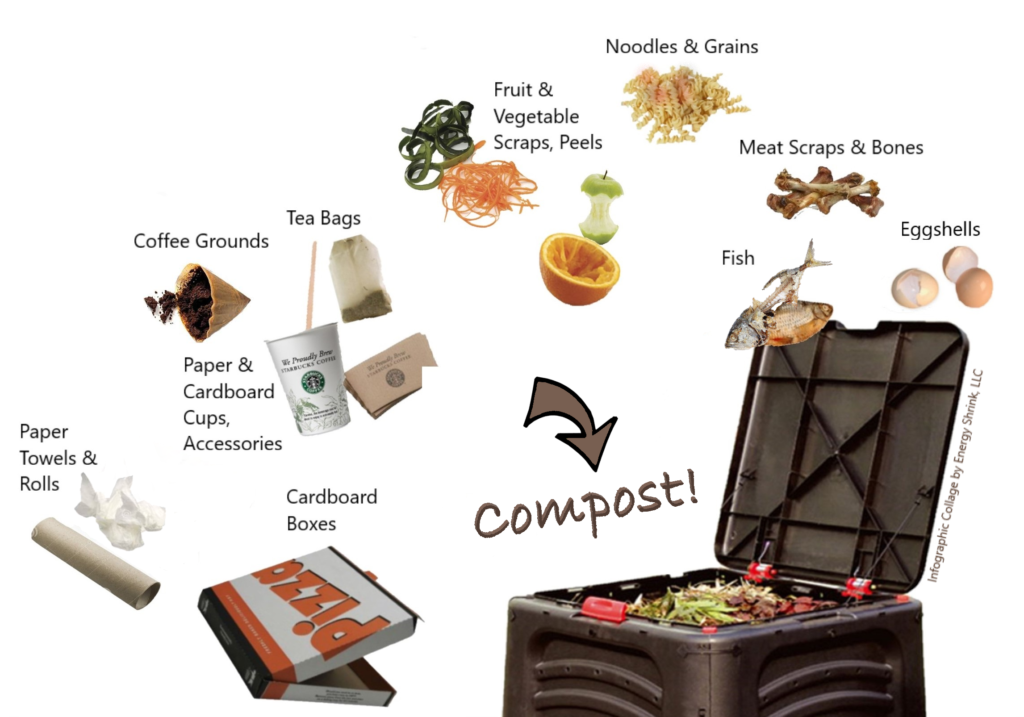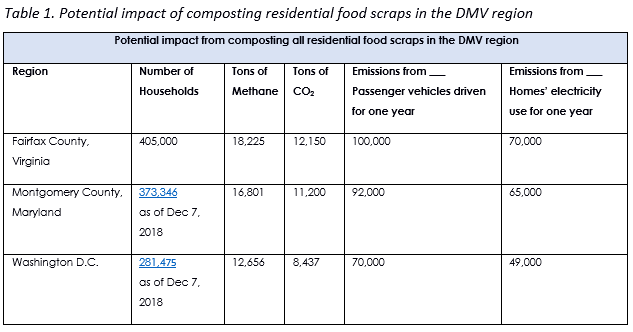Residential Composting
IMPACT COMPUTED
By Smita Chandra Thomas
Research assistance and graphics by Catherine Powell and Harshala Chandraiah
Copy editing by Jennifer Jang and Bethanie Harper
December 9, 2018
It’s the holiday season and with it comes plenty of food … and food waste. Have you thought about composting, or is it a practice you attribute to “tree-huggers”? Do you know how much of a difference it makes? At Energy Shrink, we like to put numbers to things. We have composted, calculated the impact, and want to share these findings with you. Let’s look at how composting efforts positively impact our community, and if you haven’t already, maybe you can convince your household to join in.

By composting food scraps alone, 4 households could effectively remove a car from the roads. Eight households composting food scraps could offset an average home’s electricity use per year. Composting food scraps, plus all the remaining organic waste from 1 US household, equates to removing 1.5 cars from the roads or 75% of an average home’s energy use per year.
Food is the most obvious thing to compost. The average household produces 450 lbs. (200 kg.) of food waste per year.

This estimate is based on a recent US study across three cities that determined that the average household wastes 8.7 lbs. of food per week[1]. This figure is consistent with the roughly 6 lbs. per week that lands in the compost bin from our household consisting of 2 adults and 2 kids. Our compostable waste includes not just food but also paper towels and compostable packaging (biomass). In the US, food scraps make up only about 12% of municipal solid waste (MSW). In all, about 70% of US MSW is made up of biomass and is therefore compostable. See table below[2].

Figure 1. The composition of Municipal Solid Waste MSW
Overall, the average US household produces 2 tons of municipal solid waste (MSW) per year including food amid all the other garbage.
The average person in the US produces 4.4 lbs. of solid waste daily [3]. For a typical household size of 2.58 persons [4], this equates to roughly 4,150 lbs.(4,143 lbs. to be exact) or 1,880 kg (1.88 Metric tons) of MSW per year, that is, approximately 2.07 US tons). Of this, 69.5%, or 2,880 lbs. (1300 kg) is compostable (see Figure 1 above).
Each ton of Municipal Solid Waste produces 100 Nm3 of landfill gas, equating to about 50 Nm3 of CO2 and 50 Nm3 of methane per ton of MSW with some other gases in trace amounts.
The primary gas that causes global warming is carbon dioxide (CO2), but it doesn’t act alone. In fact, many other gases also cause global warming[1]. Methane gas is one of the biggest culprits. The global warming potential (GWP) of methane is several times that of CO2 [6] [7]. A 100-year reference period is the industry standard for comparing the GWP of gases, downplaying methane’s overall impact by averaging it over 100 years. Methane lingers in the atmosphere for only a decade on average (8-12 years) compared to hundreds of years for CO2 [1]. Consequently, even though its duration in the atmosphere is shorter thanCO2’s, pound for pound, methane’s contribution to melting the glaciers is actually much greater [8].
The Municipal Solid Waste from each US household produces 0.3 tons of methane and 0.2 tons of CO2 per year.
As stated above, each US household produces 2 tons of MSW, and every ton of MSW produces 100 Nm3 of landfill gases. So, 2 tons of solid waste equates to 200 Nm3 of landfill gases, equivalent to 100 Nm3of CO2 and 100 Nm3 of methane. Several US landfills report capturing as much as 100 Nm3 of methane per ton of MSW landfilled in a given year [2]. But the Columbia paper [2] takes a conservative approach and claims half of that impact. We use the same conservative figure in our calculations here. Using the Columbia paper’s findings, (p. 1248), each ton of MSW generates 0.15 tons (0.149 to be exact) of methane. So, 2 tons of MSW is responsible for producing roughly 0.3 tons of methane. As for CO2, with each ton of MSW producing 50 Nm3 CO2, 2 tons of annual waste produces 100 Nm3 or 200 kg of CO2, or 0.2tons (1 Nm3 of CO2 equals 1.97 kg CO2.)
By composting food scraps alone, 4 households could effectively remove a car from the roads, and 8 households could offset an average home’s electricity use.
Now that we know how much greenhouse gas an average household emits, we can have some fun measuring its impact using the EPA’s handy Greenhouse Gas Equivalencies Calculator [https://www.epa.gov/energy/greenhouse-gas-equivalencies-calculator, Accessed April 22, 2018]. The results show that in the best-case scenario where every organic scrap is composted, a household’s composting could offset nearly the equivalent of its annual emissions from driving or energy use at home. [Emissions from the total compostable waste for a US household equates to 1.5 cars driven per year or 75% of an average home’s energy use]. This figure is also equivalent to 181 tree seedlings grown for 10 years! Even if homes were to compost only their food waste (450 lbs. or 200 kg or 0.2 tons per year), that would still account for 15% of the total 2,880 lbs. of the total compostable waste per year.
A residential neighborhood of 530 homes could offset the emissions from 400 homes or nearly 800 cars in the best-case scenario.

In my neighborhood of 530 homes, using the average figures, we can estimate that we produce 159 tons of methane and 106 tons of CO2 per year. The EPA calculator shows that these emissions are equivalent to 793 passenger vehicles driven for one year, or 400 homes’ energy use. The impact with composting food scraps only would be 15% of this amount.
Fairfax County could offset 3.1 million tons of CO2eq emissions every year by composting the waste from all its households, in the best-case scenario. This equates to emissions from 605,000 cars or 305,000 homes.
Virginia’s Fairfax County, where we are based, is comprised of 405,000 households. The compostable waste from these households collectively produces 1.2 million tons of methane (121,500 tons), and 81,000 tons of CO2. The EPA calculator shows that these emissions are equivalent to 605,793 cars driven for one year or the energy use of 305,481 homes. When composting only the food waste, 15% of this result could be mitigated every year. Our neighboring Falls Church City has initiated a composting program for its residents. Such programs can help a city or county meet its greenhouse emissions goals.
Some facts:
- Annual emissions at Fairfax County were equivalent to 15 million tons of CO2eq in 2005 (10% lower in 2017) [11]
- The annual CO2eq emissions of the entire US are about 7 billion tons. The US has 4% of the global population and emits about 15% of global emissions. [12]

What are the options for composting?
Why is composting food any different than biodegradation in a landfill?
To find out and read other Frequently Asked Questions and for the full list of References, download the full post at the link below.
Download Full Document Here (1386 downloads)
If we can help you calculate similar program impacts, drop us a note at thomas@energy-shrink.com